After that blunder by some local government officials from Batanes last year, we will have to wait again another year until a new Philippine site is listed in the UNESCO World Heritage list. They thought they could handle the inscription process on their own, purposely left out all the experts who prepared the bid of the Batanes Protected Landscapes and Seascapes, and got a painful rejection from UNESCO. What were they thinking? It turns out, the papers were simply not in order and had they included the heritage people involved in documenting Batanes, it would have been listed with UNESCO last year. Sad part is there is a limit to the number of sites listed per country per round. And because of Batanes' deferment, the slot meant for another Philippine site in the next round will be used by Batanes. Oh well!  I chanced upon a list of proposed UNESCO World Heritage sites. I've always known that Batanes is the next Philippine site for inscription in the prestigious list. There are more candidates on the shortlist and it may take several years before we get them in the UNESCO list. Sad to say, I've only visited one of the proposed sites, the San Sebastian Church which I will talk about in my next entry. But I wonder which churches will be included in the listing Jesuit Churches of the Philippines and and which forts in Spanish Colonial Fortifications of the Philippines since I may have seen some of them. Let me try to ask Fr. Rene Javellana since those groupings are actually books which he had written, namely "Wood and Stone for God's Greater Glory: Jesuit Art and Architecture in the Philippines" and "Fortress of Empire: Spanish Colonial Fortifications of the Philippines 1565-1898."
I chanced upon a list of proposed UNESCO World Heritage sites. I've always known that Batanes is the next Philippine site for inscription in the prestigious list. There are more candidates on the shortlist and it may take several years before we get them in the UNESCO list. Sad to say, I've only visited one of the proposed sites, the San Sebastian Church which I will talk about in my next entry. But I wonder which churches will be included in the listing Jesuit Churches of the Philippines and and which forts in Spanish Colonial Fortifications of the Philippines since I may have seen some of them. Let me try to ask Fr. Rene Javellana since those groupings are actually books which he had written, namely "Wood and Stone for God's Greater Glory: Jesuit Art and Architecture in the Philippines" and "Fortress of Empire: Spanish Colonial Fortifications of the Philippines 1565-1898." 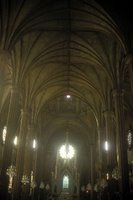 Another proposed site are the Angono Petroglyphs were declared a national cultural treasure under Presidential Decree No. 260 of President Marcos in 1973. Together with the San Sebastian Church, both sites were included in the biennial World Monuments Watch: List of 100 Most Endangered Sites in 1996 and 1998 respectively. Most of the sites are featured in the book "The National Parks and Other Wild Places of the Philippines," which came out during the term of Gemma Cruz-Araneta as DOT Secretary. These are Batanes, Mt. Pulag National Park (at 9, 586 feet, Mt. Pulag is the highest peak in Luzon) and Northern Sierra Madre Natural Park in Luzon, the El Nido Marine Reserve, and the Agusan Marsh Wildlife Sanctuary in Mindanao which is one of four Philippine sites listed in the RAMSAR List of Wetlands of International Importance. The tenth site listed is the Turtle Islands Wildlife Sanctuary in Tawi-tawi. Composed of six islands in the Sulu Sea, the marine park is part of a transnational protected area together with Malaysia that is believed to be the only remaining nesting islands for Green Turtles in the ASEAN region.
Another proposed site are the Angono Petroglyphs were declared a national cultural treasure under Presidential Decree No. 260 of President Marcos in 1973. Together with the San Sebastian Church, both sites were included in the biennial World Monuments Watch: List of 100 Most Endangered Sites in 1996 and 1998 respectively. Most of the sites are featured in the book "The National Parks and Other Wild Places of the Philippines," which came out during the term of Gemma Cruz-Araneta as DOT Secretary. These are Batanes, Mt. Pulag National Park (at 9, 586 feet, Mt. Pulag is the highest peak in Luzon) and Northern Sierra Madre Natural Park in Luzon, the El Nido Marine Reserve, and the Agusan Marsh Wildlife Sanctuary in Mindanao which is one of four Philippine sites listed in the RAMSAR List of Wetlands of International Importance. The tenth site listed is the Turtle Islands Wildlife Sanctuary in Tawi-tawi. Composed of six islands in the Sulu Sea, the marine park is part of a transnational protected area together with Malaysia that is believed to be the only remaining nesting islands for Green Turtles in the ASEAN region.  Another proposed listing which I've been hearing about but not found in the tentative list are the Spanish Lighthouses of the Philippines, many of which are featured in the book of Arch. Manolo Noche entitled "Lonely Sentinels of the Sea: The Spanish Colonial Lighthouses in the Philippines." I guess the Philippines has a long way to go in raising the consciousness of its citizens on the importance of preserving heritage. But what can we expect from a Third World country which obviously has more pressing needs? That is why heritage conservationists have to be vigilant in protecting what is left of our built heritage resources. Because when the time comes that Filipinos are mature enough to realize why heritage needs to be protected, there might not be much of it left to appreciate.
Another proposed listing which I've been hearing about but not found in the tentative list are the Spanish Lighthouses of the Philippines, many of which are featured in the book of Arch. Manolo Noche entitled "Lonely Sentinels of the Sea: The Spanish Colonial Lighthouses in the Philippines." I guess the Philippines has a long way to go in raising the consciousness of its citizens on the importance of preserving heritage. But what can we expect from a Third World country which obviously has more pressing needs? That is why heritage conservationists have to be vigilant in protecting what is left of our built heritage resources. Because when the time comes that Filipinos are mature enough to realize why heritage needs to be protected, there might not be much of it left to appreciate.
I'll definitely be blogging quite more often now that I'm done with my MBA. I just came from a business trip to Pangasinan last Sunday. While checking out some properties in Rosales, my brod Ryan Tan mentioned to me that Li-an Ramos (my kabarkada, blockmate in the UP School of Economics and co-dormer at the Kalayaan Residence Hall way back in 1997) was crowned Binibining Pilipinas Universe 2006! Wow! It seemed like only yesterday when we were freshmen at UP. Since we had the same class schedule, and stayed at the same dorm, we often walked to and from the dorm together. Good luck in the Miss Universe pageant in Vanuatu! I'm sure you will take home the crown!Anyway, we had lunch at Matutina's Seafood Restaurant in Bonoan, Dagupan City managed by the Balingit family which finds its roots in the culinary capital of the Philippines... Pampanga. It's a great beach front restaurant frequented by GMA. Sad to say, the beach area in Bonoan is not well-maintained and badly-planned. It was a chopsuey government, judicial, civic and tourist center with a jail on one end of the road and a cemetery and garbage dump on the other end. Along the road are restaurants, a Masonic lodge, the Bangko Sentral ng Pilipinas, the Hall of Justice and a Muslim community among others. And the whole stretch of the road is connected to various beach resorts and rest houses. Talk about urban planning.
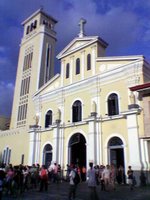 On the way back, we heard Mass in Manaoag. Finally, I was able to visit the miraculous image for the first time! Located 205 kilometers north of Manila, the Church of Manaoag is a major pilgrimage center of the Philippines owing to the popularity of the miraculous image of Our Lady of Manaoag, an image of the Nuestra Señora del Rosario. I remember passing by the old church during the HCS trip to San Fabian but we were not able to stopover. That's it for now.
On the way back, we heard Mass in Manaoag. Finally, I was able to visit the miraculous image for the first time! Located 205 kilometers north of Manila, the Church of Manaoag is a major pilgrimage center of the Philippines owing to the popularity of the miraculous image of Our Lady of Manaoag, an image of the Nuestra Señora del Rosario. I remember passing by the old church during the HCS trip to San Fabian but we were not able to stopover. That's it for now.
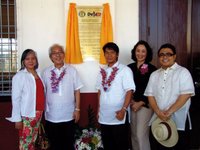 After that anxious wait, the restoration of the Pampanga High School main building, a Gabaldon schoolhouse built in the early 1930s, is finally complete. As always, members of the Heritage Conservation Society trooped to the inauguration and turnover ceremonies. And since this time around, the event was in my own turf, I was the designated driver... hehe! In our group was HCS president Gemma Cruz-Araneta, restoration architects Toti Villalon and Melvin Patawaran, and Carmen Prieto of the Dagupan Heritage Foundation.
After that anxious wait, the restoration of the Pampanga High School main building, a Gabaldon schoolhouse built in the early 1930s, is finally complete. As always, members of the Heritage Conservation Society trooped to the inauguration and turnover ceremonies. And since this time around, the event was in my own turf, I was the designated driver... hehe! In our group was HCS president Gemma Cruz-Araneta, restoration architects Toti Villalon and Melvin Patawaran, and Carmen Prieto of the Dagupan Heritage Foundation.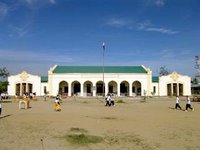 With a current enrollment of 11,000 students, the Pampanga High School is the biggest public high school in Pampanga. Its early roots can be traced back to 1902 when the Americans established the first high school in San Fernando. But due to the lack of students who made it to senior year, students were forced to finish their secondary education elsewhere. So it was not until 1912 that the first class graduated from the Pampanga High School.
With a current enrollment of 11,000 students, the Pampanga High School is the biggest public high school in Pampanga. Its early roots can be traced back to 1902 when the Americans established the first high school in San Fernando. But due to the lack of students who made it to senior year, students were forced to finish their secondary education elsewhere. So it was not until 1912 that the first class graduated from the Pampanga High School.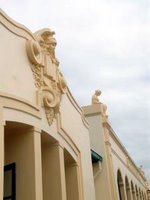 The restored main building is actually the second one since there was an earlier Gabaldon building completed around 1908 together with the Pampanga Capitol building. When the current building was completed in 1935, the older structure was reused as an annex. From 1980 up to 1995, it was used by the University of the Philippines Extension Program in San Fernando, Pampanga. What remains of that historic structure today is a result of the merciless looting and pillaging by some public officials. It stands as a harsh reminder of how badly certain leaders value their own heritage.But even the newer Gabaldon almost became a victim of well-meaning but misinformed efforts of certain indiviuals and groups. Good thing the Department of Education, through Undersecretary Mike Luz, intervened and saved the structure from a merciless renovation, including it in the DepEd-HCS Heritage Schoolhouse Restoration Program.
The restored main building is actually the second one since there was an earlier Gabaldon building completed around 1908 together with the Pampanga Capitol building. When the current building was completed in 1935, the older structure was reused as an annex. From 1980 up to 1995, it was used by the University of the Philippines Extension Program in San Fernando, Pampanga. What remains of that historic structure today is a result of the merciless looting and pillaging by some public officials. It stands as a harsh reminder of how badly certain leaders value their own heritage.But even the newer Gabaldon almost became a victim of well-meaning but misinformed efforts of certain indiviuals and groups. Good thing the Department of Education, through Undersecretary Mike Luz, intervened and saved the structure from a merciless renovation, including it in the DepEd-HCS Heritage Schoolhouse Restoration Program. Today, it stands as a testament to how heritage should and could be conserved. The Pampanga High School itself is a monument to the many leaders it molded, most prominent of which is former president Diosdado P. Macapagal of the Class of 1929. As a young kid, I was already familiarized to this outstanding group since my grandfather, Mariano D. Santos, his sister Felicidad, and their first cousin renowned pre-war journalist Amando G. Dayrit, were all members of the Class of 1929. And my lolo always beamed with pride when he showed us photos of himself together with the former president (my lolo is the one on the left). A sampling of PHS' prominent graduates can be found here.After the program, the group proceeded to Betis and Bacolor to visit their heritage churches. And our visitors were not disappointed. PHS photos courtesy of Arch. Melvin Patawaran.Related articlesPHS alumni, city government clash over heritage building
Today, it stands as a testament to how heritage should and could be conserved. The Pampanga High School itself is a monument to the many leaders it molded, most prominent of which is former president Diosdado P. Macapagal of the Class of 1929. As a young kid, I was already familiarized to this outstanding group since my grandfather, Mariano D. Santos, his sister Felicidad, and their first cousin renowned pre-war journalist Amando G. Dayrit, were all members of the Class of 1929. And my lolo always beamed with pride when he showed us photos of himself together with the former president (my lolo is the one on the left). A sampling of PHS' prominent graduates can be found here.After the program, the group proceeded to Betis and Bacolor to visit their heritage churches. And our visitors were not disappointed. PHS photos courtesy of Arch. Melvin Patawaran.Related articlesPHS alumni, city government clash over heritage building
 I chanced upon a list of proposed UNESCO World Heritage sites. I've always known that Batanes is the next Philippine site for inscription in the prestigious list. There are more candidates on the shortlist and it may take several years before we get them in the UNESCO list. Sad to say, I've only visited one of the proposed sites, the San Sebastian Church which I will talk about in my next entry. But I wonder which churches will be included in the listing Jesuit Churches of the Philippines and and which forts in Spanish Colonial Fortifications of the Philippines since I may have seen some of them. Let me try to ask Fr. Rene Javellana since those groupings are actually books which he had written, namely "Wood and Stone for God's Greater Glory: Jesuit Art and Architecture in the Philippines" and "Fortress of Empire: Spanish Colonial Fortifications of the Philippines 1565-1898."
I chanced upon a list of proposed UNESCO World Heritage sites. I've always known that Batanes is the next Philippine site for inscription in the prestigious list. There are more candidates on the shortlist and it may take several years before we get them in the UNESCO list. Sad to say, I've only visited one of the proposed sites, the San Sebastian Church which I will talk about in my next entry. But I wonder which churches will be included in the listing Jesuit Churches of the Philippines and and which forts in Spanish Colonial Fortifications of the Philippines since I may have seen some of them. Let me try to ask Fr. Rene Javellana since those groupings are actually books which he had written, namely "Wood and Stone for God's Greater Glory: Jesuit Art and Architecture in the Philippines" and "Fortress of Empire: Spanish Colonial Fortifications of the Philippines 1565-1898."  Another proposed site are the Angono Petroglyphs were declared a national cultural treasure under Presidential Decree No. 260 of President Marcos in 1973. Together with the San Sebastian Church, both sites were included in the biennial World Monuments Watch: List of 100 Most Endangered Sites in 1996 and 1998 respectively.
Another proposed site are the Angono Petroglyphs were declared a national cultural treasure under Presidential Decree No. 260 of President Marcos in 1973. Together with the San Sebastian Church, both sites were included in the biennial World Monuments Watch: List of 100 Most Endangered Sites in 1996 and 1998 respectively.  Another proposed listing which I've been hearing about but not found in the tentative list are the Spanish Lighthouses of the Philippines, many of which are featured in the book of Arch. Manolo Noche entitled "Lonely Sentinels of the Sea: The Spanish Colonial Lighthouses in the Philippines."
Another proposed listing which I've been hearing about but not found in the tentative list are the Spanish Lighthouses of the Philippines, many of which are featured in the book of Arch. Manolo Noche entitled "Lonely Sentinels of the Sea: The Spanish Colonial Lighthouses in the Philippines." 




